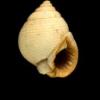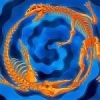In una cava calcarea in Baviera un gruppo di paleontologi tedeschi ha scoperto i resti fossili di un esemplare di cucciolo di dinosauro con una coda simile a quella di uno scoiattolo e lunghe piume filamentose simili a capelli. L’esemplare, vissuto nel tardo Giurassico, appartiene a un gruppo diverso rispetto a quello di cui fanno parte i dinosauri piumati finora noti, considerati i progenitori degli uccelli. Il dinosauro è stato chiamatoSciurumimus per la sua folta coda, che ricorda quella degli scoiattoli appartenenti al genere Sciurus. Lunghe e sottili piume filamentose simili a capelli sono state ritrovate su alcuni punti del suo corpo, come la parte anteriore, sotto il ventre, sopra le vertebre dorsali e sulla parte dorsale della coda. Secondo i paleontologi questo potrebbe suggerire che l’intero dinosauro fosse rivestito da piume. La novità della scoperta sta proprio nel fatto che, a differenza di tutti i dinosauri predatori piumati rinvenuti fino a oggi, questo piccolo di Sciurumimus non appartiene al gruppo dei celurosauri, i probabili antenati degli uccelli moderni, bensì al gruppo dei megalosauridi. Grazie al suo ottimale stato di conservazione, sarà in grado di rivelare ai paleontologi dettagli inediti sull’anatomia di questi antichi animali. La scoperta è stata pubblicata sulla rivista dell’Accademia americana delle scienze, Pnas.

Paleontologi tedeschi portano alla luce Sciurumimus, un fossile di dinosauro con i “capelli”
Iniziato da
niccosan
, Jul 03 2012 12:56 PM
Sciurumimus albersdoerferi giurassico dinosauro germania piume
1 risposta a questa discussione
#1
Inviato 03 July 2012 - 12:56 PM
#2
Inviato 03 July 2012 - 12:57 PM
Sciurumimus Albersdoerferi Dinosaur- A Feathered Theropod But Not Related To Birds
Dinosaurs are starting to look less and less like they were portrayed decades ago. The fossil of Sciurumimus albersdoerferi, which lived around 150 million years ago, is the first evidence of feathered theropod dinosaurs that are not closely related to birds.
Theropods are bipedal, mostly carnivorous dinosaurs. In recent years, scientists have discovered that many extinct theropods had feathers but feathering had only been found in theropods that are classified as coelurosaurs, a diverse group including animals like T. rex and birds.
Sciurumimus is identified as a megalosaur, not a coelurosaur and is the first exception to this rule. The new species also sits deep within the evolutionary tree of theropods, much more so than coelurosaurs, meaning that the species that stem fromSciurumimus are likely to have similar characteristics.
The fossil, which is of a baby Sciurumimus, was found in the limestones of northern Bavaria and preserves remains of a filamentous plumage, indicating that the whole body was covered with feathers. The genus name of Sciurumimus albersdoerferi refers to the scientific name of the tree squirrels, Sciurus, and means "squirrel-mimic"—referring to the especially bushy tail of the animal. The species name honors the private collector who made the specimen available for scientific study.
"All of the feathered predatory dinosaurs known so far represent close relatives of birds," said palaeontologist Oliver Rauhut, of the Bayerische Staatssammlung für Paläontologie und Geologie. "Sciurumimus is much more basal within the dinosaur family tree and thus indicates that all predatory dinosaurs had feathers."
"Under ultraviolet light, remains of the skin and feathers show up as luminous patches around the skeleton," said co-author Helmut Tischlinger, from the Jura Museum Eichstatt.
Sciurumimus is not only remarkable for its feathers. The skeleton, which represents the most complete predatory dinosaur ever found in Europe, allows a rare glimpse at a young dinosaur. Apart from other known juvenile features, such as large eyes, the new find also confirmed other hypotheses.
"It has been suggested for some time that the lifestyle of predatory dinosaurs changed considerably during their growth," Rauhut said. "Sciurumimus shows a remarkable difference to adult megalosaurs in the dentition, which clearly indicates that it had a different diet."
Adult megalosaurs reached about 20 feet in length and often weighed more than a ton. They were active predators, which probably also hunted other large dinosaurs. The juvenile specimen of Sciurumimus, which was only about 28 inches in length, probably hunted insects and other small prey, as evidenced by the slender, pointed teeth in the tip of the jaws.
"Everything we find these days shows just how deep in the family tree many characteristics of modern birds go, and just how bird-like these animals were," Norell said. "At this point it will surprise no one if feather like structures were present in the ancestors of all dinosaurs."
Published in the Proceedings of the National Academy of Sciences.
http://www.science20...ted_birds-91672
Dinosaurs are starting to look less and less like they were portrayed decades ago. The fossil of Sciurumimus albersdoerferi, which lived around 150 million years ago, is the first evidence of feathered theropod dinosaurs that are not closely related to birds.
Theropods are bipedal, mostly carnivorous dinosaurs. In recent years, scientists have discovered that many extinct theropods had feathers but feathering had only been found in theropods that are classified as coelurosaurs, a diverse group including animals like T. rex and birds.
Sciurumimus is identified as a megalosaur, not a coelurosaur and is the first exception to this rule. The new species also sits deep within the evolutionary tree of theropods, much more so than coelurosaurs, meaning that the species that stem fromSciurumimus are likely to have similar characteristics.
The fossil, which is of a baby Sciurumimus, was found in the limestones of northern Bavaria and preserves remains of a filamentous plumage, indicating that the whole body was covered with feathers. The genus name of Sciurumimus albersdoerferi refers to the scientific name of the tree squirrels, Sciurus, and means "squirrel-mimic"—referring to the especially bushy tail of the animal. The species name honors the private collector who made the specimen available for scientific study.
"All of the feathered predatory dinosaurs known so far represent close relatives of birds," said palaeontologist Oliver Rauhut, of the Bayerische Staatssammlung für Paläontologie und Geologie. "Sciurumimus is much more basal within the dinosaur family tree and thus indicates that all predatory dinosaurs had feathers."
"Under ultraviolet light, remains of the skin and feathers show up as luminous patches around the skeleton," said co-author Helmut Tischlinger, from the Jura Museum Eichstatt.
Sciurumimus is not only remarkable for its feathers. The skeleton, which represents the most complete predatory dinosaur ever found in Europe, allows a rare glimpse at a young dinosaur. Apart from other known juvenile features, such as large eyes, the new find also confirmed other hypotheses.
"It has been suggested for some time that the lifestyle of predatory dinosaurs changed considerably during their growth," Rauhut said. "Sciurumimus shows a remarkable difference to adult megalosaurs in the dentition, which clearly indicates that it had a different diet."
Adult megalosaurs reached about 20 feet in length and often weighed more than a ton. They were active predators, which probably also hunted other large dinosaurs. The juvenile specimen of Sciurumimus, which was only about 28 inches in length, probably hunted insects and other small prey, as evidenced by the slender, pointed teeth in the tip of the jaws.
"Everything we find these days shows just how deep in the family tree many characteristics of modern birds go, and just how bird-like these animals were," Norell said. "At this point it will surprise no one if feather like structures were present in the ancestors of all dinosaurs."
Published in the Proceedings of the National Academy of Sciences.
http://www.science20...ted_birds-91672

















